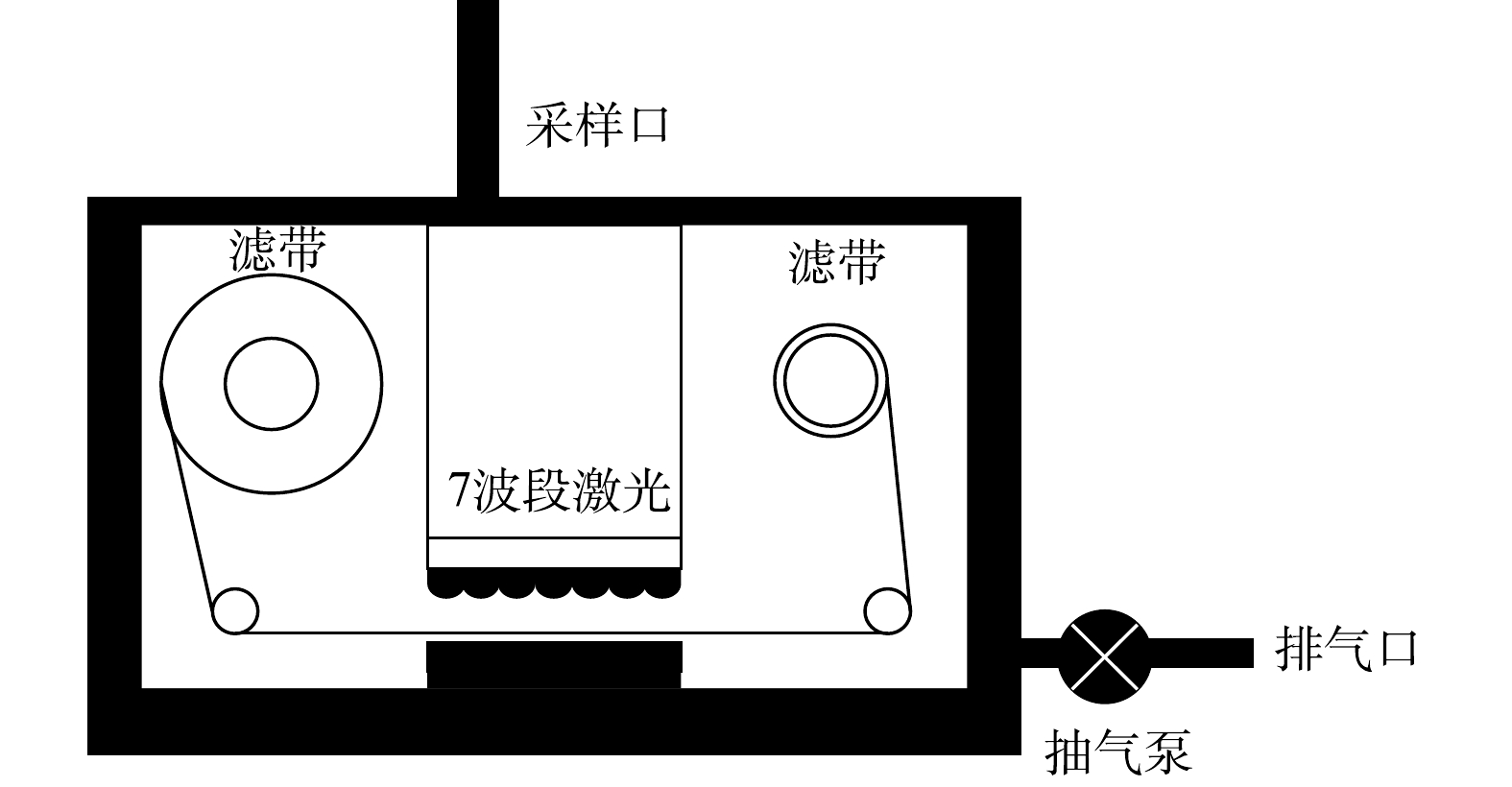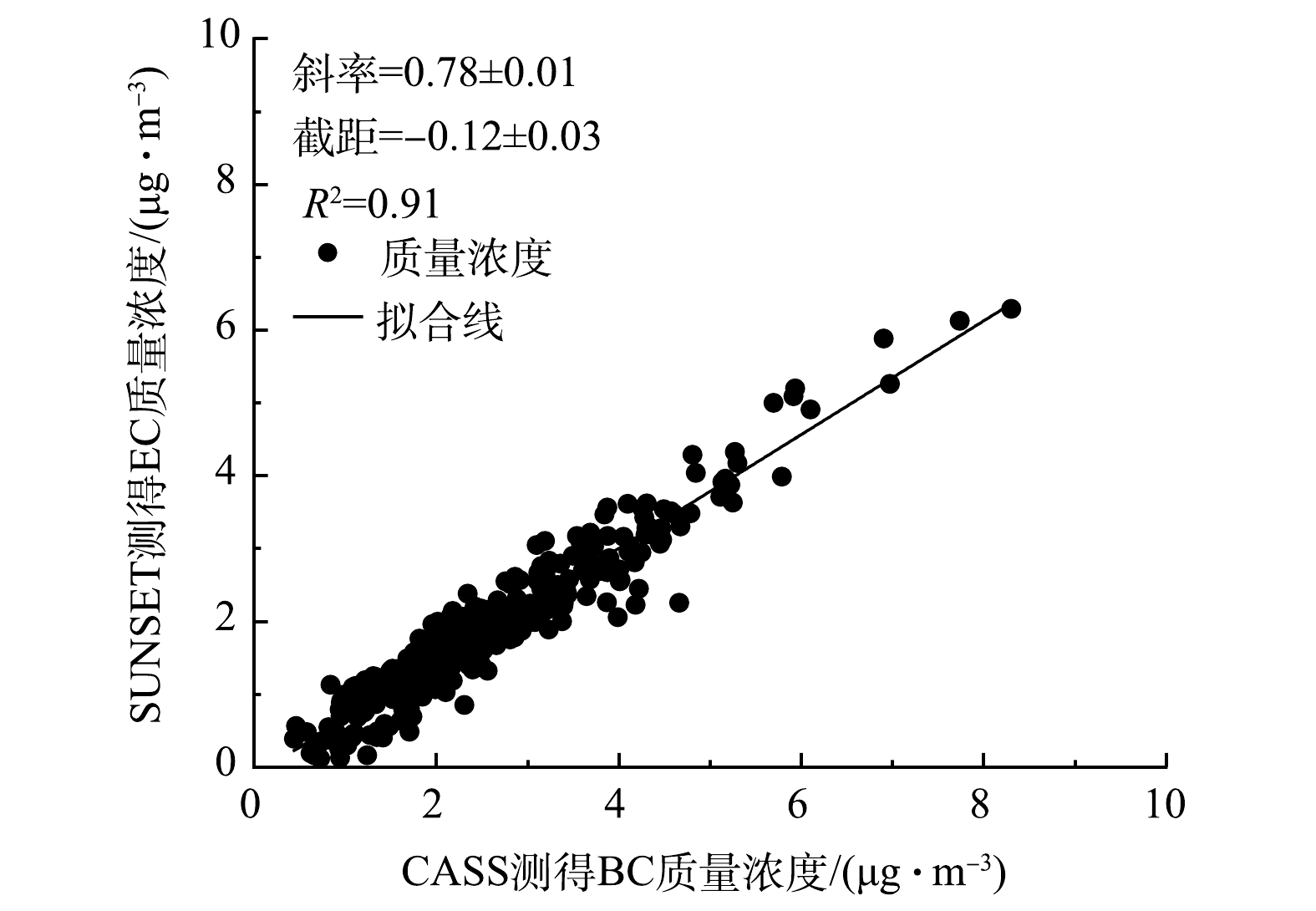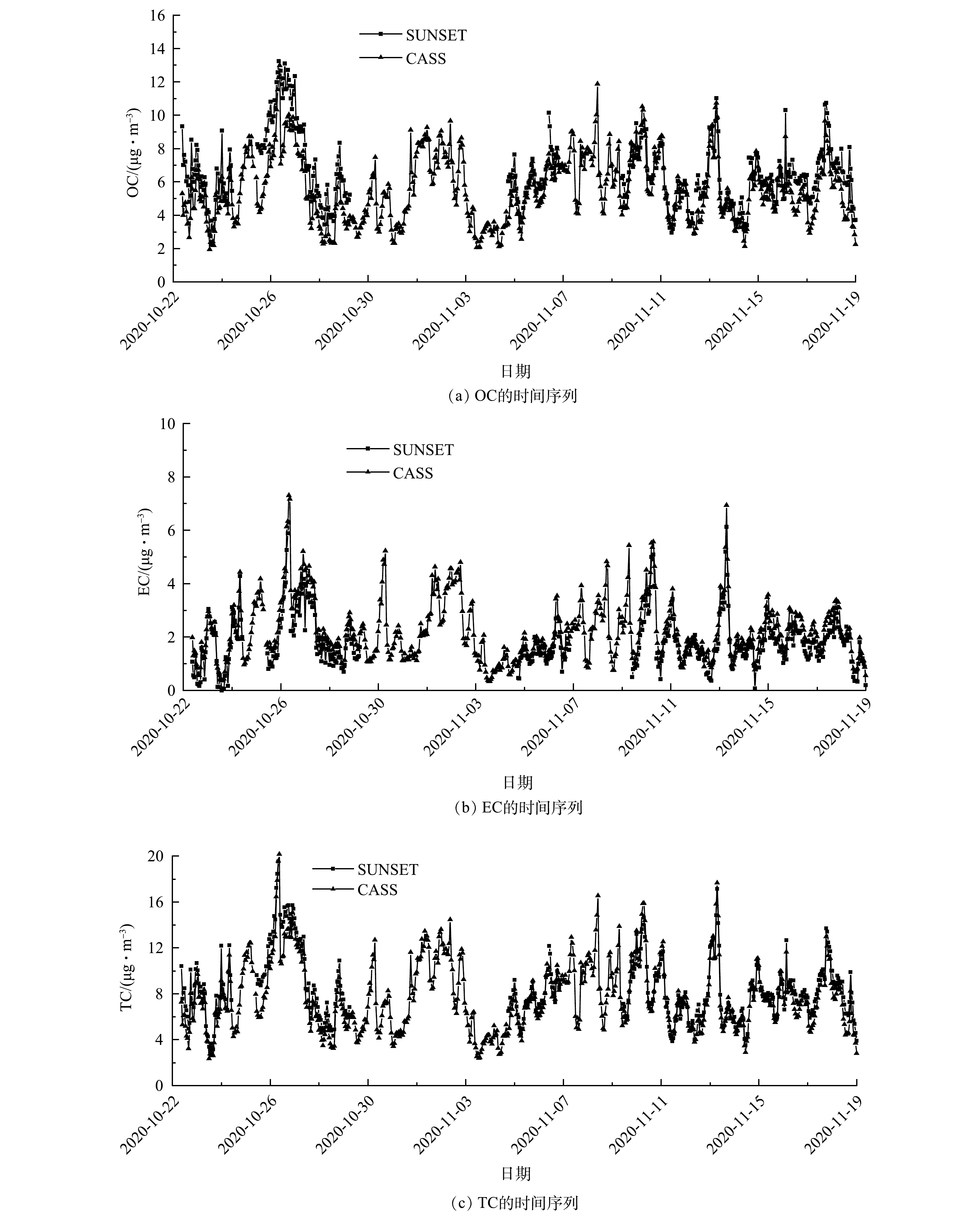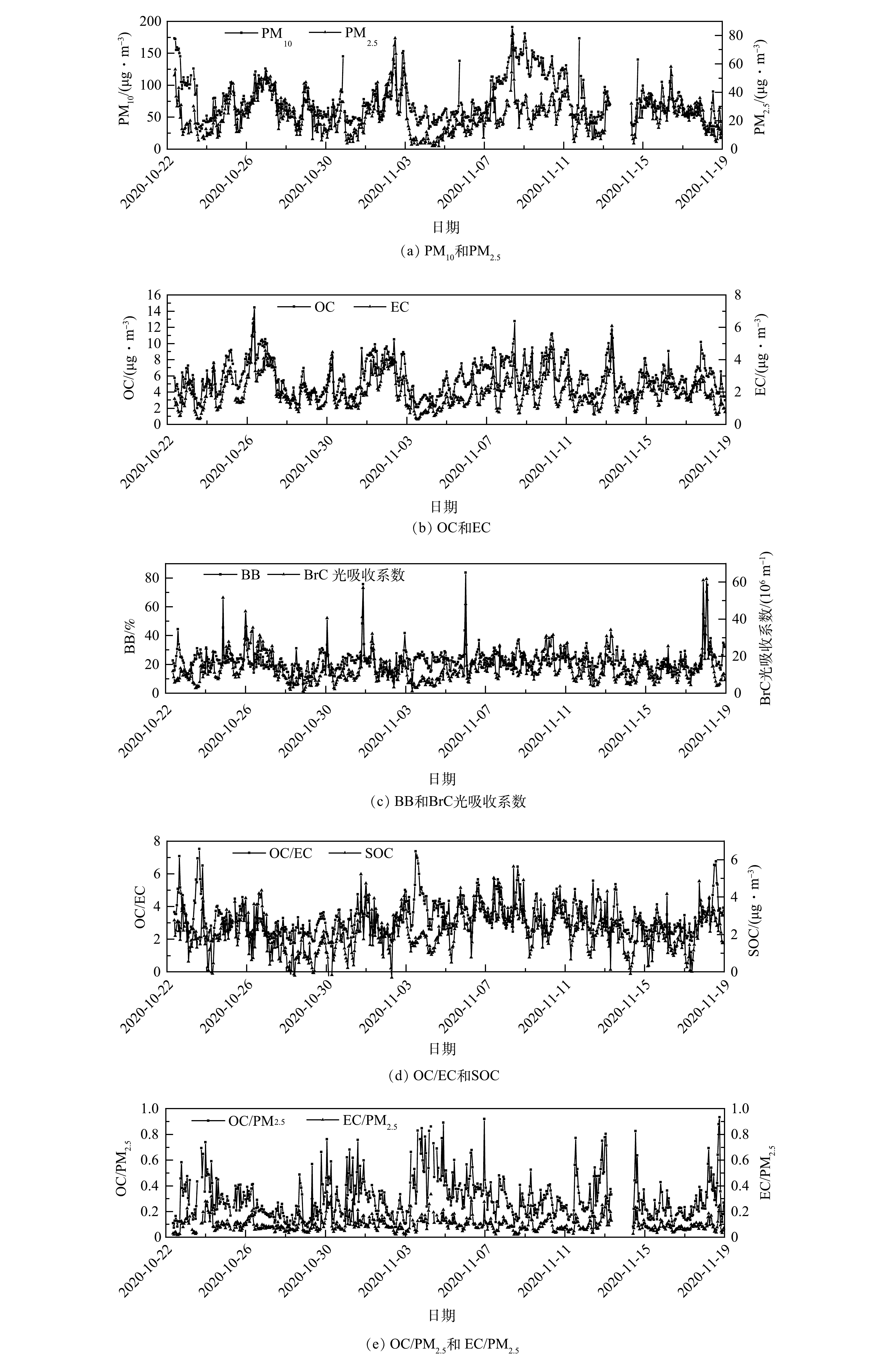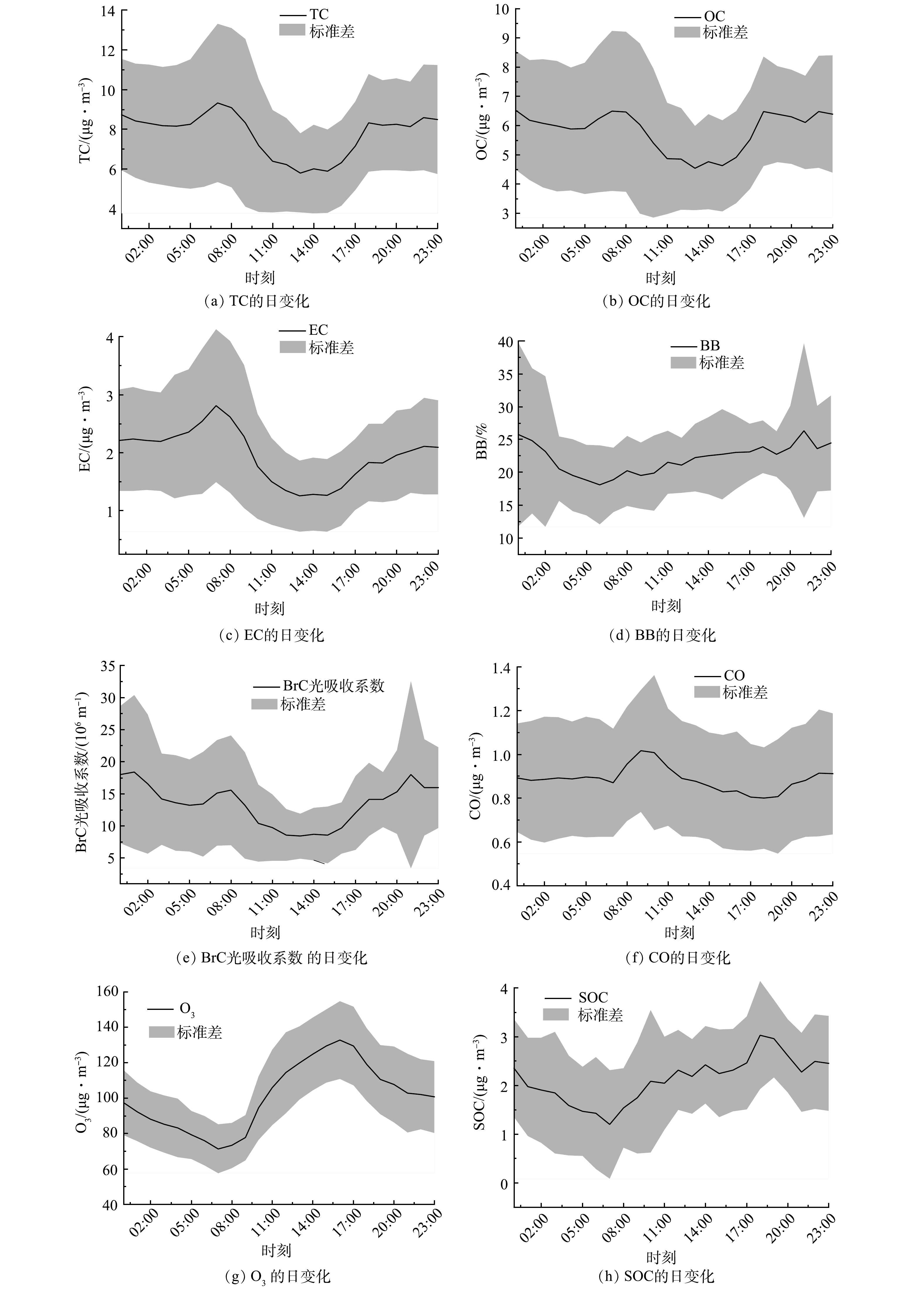-
大气细颗粒物 (PM2.5)是影响大气环境质量的重要污染物之一,它可降低太阳直接辐射和大气能见度,并影响人体健康[1]。碳质气溶胶是PM2.5的主要组成成分,约占PM2.5质量浓度的30%~50%[2-5]。碳质气溶胶根据热学性质可以分为有机碳 (organic carbon,OC) 和元素碳 (element carbon, EC),根据其光学性质又可将其分为有机碳和黑碳 (black carbon, BC)。元素碳主要来源于人为排放,包括机动车排放、工业排放和人为燃煤取暖等化石燃料燃烧以及秸秆、木材等生物质燃烧[6-7]。同时,元素碳作为重要的短期气候污染物,其直接辐射强迫效应仅小于CO2 [8]。有机碳主要包括一次排放有机碳 (primary organic carbon, POC) 以及挥发性有机物通过光化学反应或者液相反应生成的二次有机碳 (secondary organic carbon, SOC)[5, 9-11],这种分类可以更好地探寻OC的形成机制[12]。而有研究[9]发现,部分OC也在可见光波段存在明显的吸光效应,主要在紫外波段吸光,并被称为棕碳 (brown carbon, BrC),该物质也会影响大气辐射效应。除了辐射强迫效应外,OC和EC均对人类健康有害,黑碳本身就是诱导人体发生氧化应激、诱发炎症因子分泌和炎症反应的物质,对人体健康有着严重影响[13]。OC中的多环芳烃、二恶英等物质也会提高致癌风险[14-15]。
目前,OC/EC主要的测量方法为热光反射法 (IMPROVE TOR) 和热光透射法 (NIOSH TOT)[16-17],代表仪器包括DRI-2001型有机碳无机碳分析仪和SUNSET有机碳无机碳分析仪。但上述2种方法对于OC/EC的切割点均受制于分析协议的影响,不同的分析协议测量得到的OC/EC分割点及质量浓度均存在一定的偏差[18]。到目前为止,OC/EC测量方法依旧存在一定争议。CHENG等[19]通过对比IMPROVE与NIOSH协议的结果发现,不同分析协议之间的EC差异可以达到80%,并且认为这种差异是来自于SOA的影响。WU等[20]认为,热光法分析协议的差异主要来自于惰性环境最后燃烧阶段温度的差异以及切割点的不同,这种差异受制于样品中的金属化合物。KHAN等[21]也发现,较多负载物的条件下会导致透射和反射能力下降并导致测量误差。同时,热光法仪器较为昂贵且需要维持惰性气体状态,使得其使用场景被限制在实验室或是固定台站。除热光分析法外,还可以利用单颗粒质谱监测系统 (SPAMS)对多种气溶胶类型的OC/EC进行监测,但在每秒测量的单颗粒数目过高时会出现较大误差,因而对不同化学物质的检测敏感度不同;在使用SPAMS测量OC/EC时,主要测量其数浓度,但由于OC和EC气溶胶形态大小的不同,导致数浓度与质量浓度间存在一定差距[22-24]。张遥等[25]利用SUNSET与SPAMS进行了对比测量,发现对于同种污染物,SUNSET测得的质量浓度与SPAMS测得的数浓度之间相关性较差。虽然SPAMS目前已经配备在交通工具 (如:汽车、火车等)里,可用于移动测量和偏远地区监测,但通常只被用于定性分析气溶胶来源。而多波段光吸收法测量BC的方法一直被运用在大气环境监测中[26-27]。近年来,随着研究的深入,环境科学中的EC与大气科学中的BC的结合越来越紧密,也出现了新的碳质气溶胶测量方法[28]。因此,碳气溶胶组分在线分析系统 (CASS) 开始应用于环境监测。该系统由AE33黑碳仪与TCA08总碳分析仪组成,2个仪器分别测量BC和TC的技术已经十分成熟[26, 29-30],但是,结合计算OC/EC的方法目前使用较少[28, 31]。RIGLER[28]在2019年提出了连用TC-BC的方法测量OC/EC,并在2020年将TCA08和AE33黑碳仪连接成集成式OC/EC测量仪器。倪登峰等[32]在济南市使用SUSNET与CASS进行了对比观测,确定在济南市BC/EC系数为0.9437,并认为CASS很好地避免了VOCs的影响,使测量更加稳定。此外,由于CASS系统的光学模块是由AE33组成的,因此AE33溯源功能也保留在CASS系统中。利用SANDRADEWI等[33-34]开发并被广泛应用的黑碳仪模型,可以区分EC中生物质燃烧和化石燃料燃烧的来源,也可以分析BrC的吸光性[35-36]。
本研究利用CASS系统与在线SUNSET OC/EC分析仪在南京市同一地点、同一时段对碳质气溶胶组分进行平行在线观测并对2种测量方法进行对比评估,利用CASS系统分析采样期间南京市北部郊区OC、EC、SOC的质量浓度以及BrC吸光特征和EC来源,探究CASS系统在测量大气中碳质气溶胶方面的准确性和实用性,以期为CASS系统在大气污染监测中的实际应用提供参考。
-
采样点位于南京信息工程大学教学楼顶 (32.207°N,118.717°E),采样日期为2020年11月20日—12月20日。CASS系统与SUNSET分析仪独立采样,相隔距离约10 m。这可以保证采样管头之间并不会互相干扰,其余条件保持一致 (站房环境温度等条件),且2台仪器采样分析频率均为1 h,24 h连续不间断采样(除降水、断电等情况)。PM2.5和PM10来自中国环境检测平台实时发布的最近站点逐小时数据。
-
本研究中,热光法测量利用的仪器为RT-4型双波段 SUNSET OC/EC 分析仪,使用升温程序为NOISH5040,搭配PM2.5旋风切割头,采样流量为8 L·min−1。热光发的主要分析原理如下。首先,在惰性气体条件下,逐渐升温,使得OC裂解,通过氧化炉以CO2的形式被检测出来并进行定量分析。第二,在氧气环境中催化氧化EC并以CO2的形式被检测出来,所用的检测器为非色散红外检测器 (NDIR)。在OC裂解的过程中会出现碳化现象,导致 EC的质量浓度会被高估,因此,在分析过程中,需要有一光源持续照射采样膜并对膜透射光信号进行测量,用于修正误差;在燃烧过程中,OC与EC的分割点为激光恢复到分析前光强度的位置,该点之前为有机碳和碳化碳,该点之后为无机碳[17]。但受不同的分析协议影响,有机碳碳化程度存在一定的差异[18]。在无氧条件下,过高的燃烧温度会导致碳化更加明显[20]。第三,碳质气溶胶总含量为各个碳质组分的加和,通过加和上述2个阶段计算得到的OC和EC质量浓度,得到TC的质量浓度。该质量浓度为气溶胶的总含碳量,不受碳化影响,这是因为OC碳化生成的EC也是TC的一部分。
-
CASS测量系统主要分为总碳分析单元和黑碳测量单元2个部分。总碳分析单元为TCA08总碳分析仪,该仪器有2个相同的燃烧室,可以实现2个炉室轮换使用,分析协议为IMPROVE_A,采样流量为16.7 L·min−1,采样膜的有效采样面积为4.9 cm2。TCA08总碳分析仪结构如图1所示。
在图1中,2个燃烧炉既可单独使用也可以切换使用。在采样过程中 (以燃烧炉1为例),仪器右下端的采样泵以16.7 L·min−1的流速持续抽气,大气颗粒物随着采样气体入口进入燃烧炉1并被采集在燃烧炉1和燃烧炉2中的石英滤膜上。采样结束后,自动切换阀门1和阀门2把仪器切换至分析状态,仪器左下端的分析过程泵以0.5 L·min−1的流速抽取气体存储罐中的载气进入燃烧炉1,同时燃烧炉1被加热至940 ℃。在此过程中,气溶胶燃烧产生的CO2会被左下端的NDIR分析装置检测到并形成一个变化的峰型图。由于载气中的CO2被预设为基线,可以通过计算峰形图高于基线部分的CO2信号强度值来换算得到TC的质量浓度。
BC测量单元使用1台AE33型黑碳仪,该型号黑碳仪使用7个波段的激光 (λ = 370、470、520、590、660、880和950 nm) 对采集到滤带上的样品进行照射并测量其光衰减量。在测量过程中,以2个不同流量(流量1 = 4 L·min−1,流量2 = 1 L·min−1,采样总流量为5 L·min−1)同时进行采集并用于负载校正。黑碳仪简易结构如图2所示。
可见光波段主要的吸光物质为EC,黑碳仪通过测量负载有气溶胶的滤带的衰减程度来定量EC,而通过这种方法测量得到的EC由于受到形态和部分棕碳的影响,导致测量结果通常高于热光法的EC,所以通常被称为BC。AE33通过持续测量滤带光衰减的量得到BC的质量浓度,计算结果受到流量和滤带属性的影响。具体计算方法如式 (1) 所示。
式中:CBC,M是通过单点计算出来的BC质量浓度,μg·m−3;I0和I分别为空白滤带和含有气溶胶的滤带的激光强度;S为滤纸样品截面积,m2;Fin为实时采样流量,L·min−1;h为滤带对光的散射导致的增强因子;σair为质量吸收截面,m2·g−1;Δt为2个测量时刻之间的时间差,s。随着BC在采样的过程中的积累会出现负载效应,导致采样结果被低估[26],AE33两点测量可以很好地校正这个问题,计算方法如式 (2) 所示。
式中:CBC为校正后得到的BC,μg·m−3;k为负载校正系数;Atn为光衰减系数。
最终,结合TCA08测量得到的TC和AE33测量得到的BC计算得到碳质气溶胶组分结果,计算方法如式 (3)和式(4) 所示。
式中:CTC、CEC、COC、CBC分别为颗粒物中的总碳、元素碳、有机碳和黑碳的质量浓度, μg·m−3;b为CBC与 CEC 的转换系数,该系数受到采样地点BC气溶胶的老化情况与光学形态影响,仪器默认值为0.8,一般在使用前应当进行一轮校正。
-
系统CASS与在线SUNSET OC/EC分析仪不仅测量原理不同,指标设定也存在一定差异 (表1)。CASS采样流量为16.4 L·min−1,采样膜面积为4.9 cm2;SUNSET的采样流量为8 L·min−1,采样膜直径为17 mm (有效面积为2.27 cm2),在单位时间内CASS采集的碳质气溶胶更多;分析流量也存在一定的差异,CASS为0.5 mL·min−1,而SUNSET由于分析协议的设定不同,存在一定的差异,平均流量约为70 mL·min−1。CASS是由总碳分析仪 (TCA08) 与黑碳仪 (AE33) 组合而成,EC的质量浓度是由AE33测量得到的BC的质量浓度转换而来的,AE33采样流量为5 L·min−1,分析频率为60 s;TC的质量浓度是由TCA08采用IMPROVE分析协议测得的,与SUNSET采用NIOSH分析协议测得的结果差距较小[37]。
除此之外,CASS为双炉设计:在一个燃烧炉中,测量总碳气溶胶的质量浓度;在另一个燃烧炉中,进行气溶胶的采样工作。因此,CASS的逐时采样时间为60 min,同时可以保证分析时间为20 min。由于SUNSET为单一炉管设计,只能在分析程序和采样程序之间切换,故对于SUNSET而言,逐时的分析结果为45 min的采样加15 min的分析时间。CASS的载气为过滤气溶胶后充分混合的环境空气,SUNSET却需要外接He及He/O2气体以保证仪器内部的气体环境,通常情况下需要外接多瓶载气,这样使得SUNSET在移动测量过程中存在一定的限制,且需要较高的维护成本。两者相比,CASS可以很好地节约成本,而且在进行移动测量时更为方便,更适合在偏远地区使用。
另外,热光法在加热过程中破坏EC形态,使得EC最终以CO2的形式被检测到。而CASS在测量EC的过程中是通过多波段光吸收的方法测量的,该方法在测量过程中会受到EC气溶胶形态及棕碳气溶胶的影响。因此,通常以SUNSET测得的EC质量浓度作为基准,计算CASS的EC质量浓度并对CASS系统中EC的测量误差进行校正[28]。
-
SOC是OC的重要成分之一,SOC/OC反映了本地有机碳质气溶胶中二次生成的占比。本研究中SOC的计算采用MRS法[38],主要的计算方法如式 (5) 所示。
式中:CSOC为SOC的质量浓度,μg·m−3;MOC⁄EC,pri为通过MRS方法确定(OC/EC)pri的值。该方法通过假设 (OC/EC)pri的值计算SOC,当计算得到的SOC与OC相关性最小的时候,即当R2最小时得到的 (OC/EC)pri就是所需要的数值,将数值带入后可以计算出所需要的SOC质量浓度。
-
CASS系统可以计算EC的来源贡献。BC的光吸收遵循比尔朗博定律[39],不同波段的BC的吸收系数计算方法见式 (6)。
式中:babs,λ为波长为λ的光对BC的光吸收系数;α为Ångström指数。颗粒物中不同的物质对不同波长的光的Ångström指数有明显的不同。在950 nm处,除BC外,其他气溶胶基本上不吸收光,因此,可以对 BC 的质量浓度进行定量。假设国内 BC 主要的来源为机动车排放和生物质与煤炭燃烧[34],在波长 950 nm 处检测到的BC来源贡献关系见式(7)。
式中:babs,BC为 950 nm 处总的光衰减系数;babs,BC_ff为化石燃料燃烧源造成的光衰减值;babs,BC_bb为生物质和煤炭燃烧来源造成的光衰减值。化石燃料燃烧来源和生物质燃烧来源的Ångström指数计算方法[33]见式 (8)和式 (9)。
式中:αff为化石燃料燃烧来源的Ångström指数;αbb为生物质燃烧来源的Ångström指数;babs,950_ff 为化石燃料燃烧来源在950 nm所占的光吸收系数;babs,950_bb 为生物质燃烧和煤炭来源在950 nm所占的光吸收系数;babs,470_ff 为化石燃料燃烧来源在470 nm所占的光吸收系数;babs,470_bb 为生物质燃烧和煤炭来源在470 nm所占的光吸收系数。而来自不同源的BC可以通过950 nm换算得到,计算方法见式(10)。
式中:CBB为生物质与煤炭燃烧的占比;babs,950_bb 为BC在950 nm所占的光吸收系数;babs,950为生物质燃烧和煤炭来源在950 nm所占的光吸收系数。
-
根据式 (6),假设880 nm之后的吸光性物质仅为黑碳气溶胶,而黑碳气溶胶的Ångström指数为1,计算方法[36]见式 (11)。
式中:babs,370_BrC为在370 nm处测得的棕碳吸光系数;babs,370 为在370 nm处测得的总吸光系数;babs,880为在880 nm处测得的总吸光系数;αBC为BC的Ångström指数,带入值为1;棕碳在370 nm处的光吸收占比为babs,370_BrC和babs,370的比值。
-
CASS系统的EC的确定与BC的测量结果密切相关,所以EC与BC的转换系数尤为重要[28, 31]。BC与EC的转换系数受到本底气溶胶的组成以及BC气溶胶老化程度的影响,通过对比SUNSET测量得到的EC和AE33在880 nm得到的BC可以看出本底黑碳气溶胶的老化程度,从而确定CASS测量过程中转换系数b值。
如图3所示,SUNSET测得的EC与AE33测量的BC变化趋势较为一致,R2可以达到0.91 (p < 0.05)。这说明EC和BC的测量结果存在较好的一致性。样品之间的差距可能来自于测量方法的差异以及采样设定的差异。BC结果为每个60 min测量的60 s高频BC分析结果的平均值,而EC为SUNSET在每个60 min中前45 min采样结果的分析值。虽然采样时间相差15 min,但是从相关性来看,误差在可接受范围。而对比斜率来看,BC小时平均结果普遍大于EC结果,为(0.78 ± 0.01) μg·m−3,而截距为(−0.12 ± 0.03) μg·m−3。通过截距可以看到两个仪器的零点差距并不大,仅仅0.12 μg·m−3,南京市PM2.5中EC质量浓度约为1.5 ~ 4 μg·m−3,截距误差在10%以下。而斜率显示BC质量浓度约为EC的1.3倍,相较于珠三角地区的1.5倍而言较低[35],而在美国5城市的测量过程中该比值为0.77,与本研究相仿[40]。所以,本研究在之后CASS的测量过程中将EC与BC的转换系数b带入为0.78。
-
对CASS系统和SUNSET开展同步连续观测,测量结果时间序列图如图4所示。因途中出现降水天气及仪器维护工作,导致缺少4 d的对比结果。相较而言,CASS系统在雨天可以正常待机使用,受到极端天气影响较少。
在观测期间,CASS系统与SUNSET测量的TC、OC和EC的质量浓度变化趋势保持一致。SUNSET和CASS测量的TC平均质量浓度分别为 (8.32±2.81) μg·m−3和 (7.66±2.86) μg·m−3,相差 (0.66 ± 0.89) μg·m−3,约占整体质量浓度的5%。2台仪器的EC结果分别为 (1.80±0.98) μg·m−3和 (1.93 ± 0.94) μg·m−3,相差 (0.15 ± 0.29) μg·m−3,约占整体的7.5%。这与南京市历年统计的结果[41-42]较为一致。在2020年10月25日前后,EC误差较为明显。这主要是由于污染后期,气溶胶二次反应和老化较为严重,气溶胶形态效应导致CASS测得的EC质量浓度被高估。由TC和EC的测量值对比结果看出,2台仪器测量差距不大,误差均在10%以内。2台仪器的OC结果分别为 (6.52±2.05) μg·m−3和 (5.73±2.01) μg·m−3,相差(0.79 ± 0.99) μg·m−3,约占整体的11%。出现这样的结果,一方面是由于SUNSET出现的测量时间差异导致的,另一方面也是由于CASS计算方法误差叠加的影响,通过回归分析可以进一步判断差距。
如图5所示,2台仪器测出的碳质气溶胶结果较为一致 (R2均在0.9以上)。TC和EC的斜率分别为1.04和1.05,均在1左右。这表明对于TC燃烧测量而言,不同的测量方法对结果影响并不明显。但是TC存在 (0.84±0.03) μg·m−3的截距,即当SUNSET测量结果为0 μg·m−3时,CASS系统测量的TC为0.84 μg·m−3,这部分来源很可能与CASS测量原理本身有关。SUNSET本身是在惰性气体及纯氧条件下测量TC,背景中并无多余CO2存在,但是CASS测量系统是将每个样品的环境空气过滤气溶胶后混合,稳定后作为载气,CASS的载气可用性受过滤效率以及载气中CO2稳定性的影响。在混合CO2过程中,利用10 L的容积进行混合,虽然基线的波动相较于燃烧碳质气溶胶产生的CO2脉冲小很多,但是在具体分析过程中可能产生基线CO2质量浓度漂移,导致部分背景载气作为碳质气溶胶燃烧产生的CO2被算入样品中。而截距可表征2个仪器在测量低值时的误差,该误差占TC和EC平均质量浓度的10%以下,对仪器正常测量影响较小,且可以进行校正。
对于EC的测量结果,存在0.29 μg·m−3的截距,即在SUNSET测量结果为0 μg·m−3时,CASS结果为0.29 μg·m−3,该截距可能同时受SUNSET检出限和黑碳气溶胶老化所导致的误差的影响。CASS系统测量EC的方法为多光谱光吸收法,该方法测量检出限为5 ng·m−3,而SUNSET热光法EC的检出限为0.5 μg·m−3,截距在SUNSET检出限以下。在SUNSET测量过程中,对低质量浓度EC的测量准确度不高,可能会出现EC质量浓度被高估的情况。若剔除小于0.5 μg·m−3结果后,截距变为0.21 μg·m−3。这是因为光吸收法测量的BC受到气溶胶老化程度的影响,CASS在测量过程中对这种老化进行了统一假设,所以在测量过程中可能出现明显被高估的情况,使得测量结果出现一定的差异。
对比TC与EC的测量结果,OC的斜率的偏差较大,为0.87±0.02,截距为 (0.09±0.16) μg·m−3。这反映了SUNSET测量得到的OC较CASS更大,尤其在污染较强的天气。由于TC和EC的斜率均表现良好,因此,可认为OC测量结果中的偏差主要是由于CASS在计算过程中误差叠加了载气以及黑碳气溶胶老化影响所导致的。
-
通过以上分析可以看出,CASS系统与SUNSET在测量碳质气溶胶组分过程中具有较好的一致性。CASS和SUNSET均可以通过MRS对二次有机碳质气溶胶进行分析,而相较于SUNSET而言,CASS系统可以通过7波段的BC测量结果和黑碳仪模型对EC组分来源进行分析,从而区分EC中生物质燃烧来源及化石燃料燃烧来源贡献的占比,还可以通过BrC吸光计算方法对PM2.5中的棕碳进行分析。因此,利用CASS可分析整个观测期间OC、EC、生物质与煤炭燃烧占比 (BB)、BrCabs、SOC、OC/EC等,分析结果如图6所示。
如图6所示,在2020年秋季, 监测点位PM2.5平均质量浓度为 (23.88±12.91) μg m−3,与2015年秋季的PM2.5质量浓度 (54.1±28.9) μg m−3相比,下降了55%;OC/EC结果为 3.28±0.98,与2015年的7.4相比,下降了55%[43]。SOC平均质量浓度为 (2.13±1.07) μg·m−3,SOC/OC为 38.79%±15.64%,这反映了南京市北部郊区秋季OC的来源主要以一次排放为主。MRS计算出的(OC/EC)pri数值为1.89,与北京市夏季的1.0[44]和2015年南京市秋季的1.53[43]相比,数值偏高,而与天津市夏季的监测结果(1.84~2.04)[45]较为一致。值得一提的是,在2020年10月26日前后, SOC的数值被低估。这是由于CASS受到重污染天气下老化气溶胶的影响而导致的。假设该阶段EC被高估 (0.5~1.5 μg·m−3),由MRS重新计算的SOC数值可以看出,整体SOC被低估了1.5%~7.4%。而OC/PM2.5为 30.66% ± 16.07%,EC/PM2.5为 9.88%± 5.58%,碳质气溶胶占比为40%,比北京市[9]高10%左右。这主要是由于2地工业产业结构的差异所导致的,同时因北京市地形特殊,容易汇聚周边传输污染物,从而导致PM2.5质量浓度持续增高。
如图7所示,在整个研究期间,EC中BB的占比为 22.10%±7.32%,化石燃料燃烧来源(FF)占比约为80%。此结果与往年相比无明显变化[46-47],但与北京市相比,化石燃料占比较高[48]。BrC在370 nm的光吸收系数为 (13.33±8.08) ×106 m−1,占整体吸光的 21.18%±6.91%。当PM2.5和PM10质量浓度增加时,OC和EC随之增加,同时BrC的吸光占比也在增加 (图7)。但BB在EC中的占比持续下降(自25%下降至20%),污染物增加的同时,BB占比有所减少。这间接反映了FF占比的增加 (自75%升至80%),同时也反映了南京市北部郊区在污染过程中,EC的上升主要来源于化石燃料来源排放的增加。
由图8可以看出,TC、OC和EC均在07:00出现了明显的高峰,峰值分别可以达到 (9.31±3.98) 、(6.53±2.74) 和 (2.81±1.32) μg·m−3。OC峰值与夜间值相差不大,均在6 μg·m−3,但EC早高峰值较夜间值更高,这主要是由于早高峰机动车的排放造成的。除此之外,边界层条件在日出前最低,这有利于早高峰污染物的积累。BB日最低值出现在06:00—07:00,为 18.10%±6.01%,此时FF的值最大;CO的峰值出现在07:00—08:00,为 (1.02±0.28) μg·m−3。已有研究[49-50]表明,早高峰时CO的升高与机动车行驶量的增加有关,在早高峰污染物中,机动车来源贡献有所增加,这与南京市2019年的研究结果[41, 46]一致。BrC的峰值出现在01:00,为 (18.40±12.00)×106 m−1,此时BB和SOC也均在峰值左右。这是由于BrC本身就是一种OC,和SOC存在一定关系,从而证明了夜间有二次棕碳的生成[51]。SOC高峰出现在18:00左右,为 (3.03±1.11) μg·m−3,整体变化趋势与O3一致,BrC在08:00和20:00出现高值。整体看来,南京市北部郊区的碳质气溶胶峰值主要在早高峰出现,这种现象主要是由于机动车排放导致的。早高峰结束直至夜间,二次生成的碳质气溶胶会不断增多并在日落时出现峰值。棕碳则在夜间出现峰值,在早高峰和日落时出现高值,这是由于人为活动造成的棕碳的一次排放[52]以及大气中棕碳的二次生成导致的[53-54]。
-
1) CASS系统测得的BC与SUNSET测得的EC变化趋势较为一致 (R2=0.91,p<0.05)。 CASS中BC/EC转换系数在南京市北部郊区秋季设定值为0.78,在不同地点及不同时段,频繁校正该值,可以保证测量结果受到气溶胶形态的影响最小。
2) CASS系统校正后与在线SUNSET测得的TC、OC和EC质量浓度具有较好的一致性,斜率可以达到1.04 (R2=0.9)、0.87 (R2=0.92)、1.05 (R2=0.92)。但是,由于2台仪器在检出限和测量方法上的差异,依旧会造成10%以内的测量误差。
3) CASS系统测得的南京市2020年秋季TC、OC、EC的质量浓度结果显示,TC质量浓度为 (7.66±2.86) μg·m−3,OC、EC质量浓度分别为 (5.81±2.13) μg·m−3和 (1.95±0.97) μg·m−3,分别占PM2.5的30%和10%左右,SOC占OC的40%左右。TC、OC和EC的峰值均出现在清晨,而SOC峰值则出现在傍晚。此外,南京市EC主要来源为化石燃料燃烧 (占比约为80%),夜间BrC光吸收系数高于白天。
4)新型碳质气溶胶在线分析系统(CASS)经过校正后,与传统的热光法SUNSET OC/EC分析仪同样具有良好的测量精度,且CASS具有独特的载气功能以及测量方法,使其维护和移动观测更加方便。除此之外,黑碳测量模块可以自动计算黑碳气溶胶来源,也可以计算棕碳的光吸收占比。但CASS系统在测量前,需要对BC/EC转换系数进行确认,否则可能会造成较大的系统误差。
新型碳质气溶胶(OC/EC)观测方法的应用效果分析
Application effect analysis of new carbonaceous aerosol (OC/EC) observation method
-
摘要: 为探究新型碳气溶胶组分在线分析系统(CASS)对大气中碳质气溶胶测量的准确性和实用性,将CASS系统与在线SUNSET OC/EC分析仪测量结果进行了对比,并应用CASS系统对南京2020年秋季大气碳质气溶胶的组分进行了分析。结果表明:在南京北部郊区秋季用CASS系统测量,其黑碳 (BC) 与元素碳 (EC) 的计算系数为0.78;经校正后的CASS系统所测得的总碳 (TC)、有机碳 (OC) 和EC结果与在线SUNSET OC/EC分析仪的测量结果具有较好的一致性,斜率分别为1.04 (R2=0.9)、0.87 (R2=0.92)、1.05 (R2=0.92),2台仪器的各个碳质组分的测量误差在10%以内;OC和EC分别占PM2.5的32%和10%左右,二次有机碳 (SOC) 占OC的38%左右;EC主要来源为化石燃料燃烧 (占比约80%);棕碳 (BrC) 在370 nm处的光吸收占比为 21.18%±6.91%,一次排放污染物居多。综上所述,经过校正后的CASS系统与传统的热光法SUNSET OC/EC分析仪相比,两者的测量结果较为一致;CASS可以分析EC的来源,也可以计算棕碳的吸光占比;CASS具有独特的载气功能以及测量方法,维护和移动观测更加方便,且更加适合于偏远地区。本研究成果可为CASS系统在大气污染监测中的推广应用提供参考。
-
关键词:
- 碳质气溶胶 /
- 碳气溶胶组分在线分析系统(CASS) /
- 热光法 /
- SUNSET OC/EC分析仪 /
- 对比分析
Abstract: In order to explore the accuracy and practicability of measuring carbonaceous aerosols in the atmosphere by the new carbonaceous aerosol speciation system (CASS), a contrastive study of measuring results between CASS system and the online SUNSET OC/EC analyzer was conducted, and the former was used to analyze carbonaceous aerosols in Nanjing in autumn of 2020. The results showed that the calculation coefficient of internal black carbon (BC) and elemental carbon (EC) was 0.78. The total carbon (TC), organic carbon (OC) and EC determined by the calibrated CASS system were in good agreement with those by the online SUNSET OC/EC analyzer with respective slope of 1.04 (R2=0.9), 0.87 (R2=0.92), and 1.05 (R2=0.92), and the measurement errors of each carbonaceous component determined by the two instruments were within 10%. In addition, OC and EC accounted for about 32% and 10% of PM2.5, respectively, and secondary organic carbon (SOC) accounted for about 38% of OC. The main source of EC was fossil fuel combustion with a ratio of about 80%. The ratio of light absorption by brown carbon (BrC) at 370 nm was (21.18±6.91)%, which was mainly the primary emission pollutant. Overall, the measurement results of the calibrated CASS were consistent with those of the traditional thermal-optical SUNSET OC/EC analyzer, and the former could analyze the source of EC and the light absorption ratio of brown carbon at 370nm. In addition, the unique gas-carrying function and measurement method in CASS made it more convenient for maintenance and mobile observation, as well as more suitable for remote areas. The research results can provide a reference for the popularization and application of CASS in air pollution monitoring. -

-
表 1 CASS与SUNSET的参数对比
Table 1. Comparison of CASS and SUNSET parameters
仪器 载气 检测器 分析协议 采样流量/
(L·min−1)采样膜
面积/cm2分析流量/
(mL·min−1)采样
时间/min分析
时间/min计算方法 CASS 空气 NDIR IMPROVE_A 16.4 4.9 500 60 20 COC =CTC−CEC SUNSET He 与He/O2 NDIR NOISH5040 8 2.27 70 45 15 CTC = COC+CEC 注:CTC为SUNSET通过计算得到总碳的质量浓度;COC为SUNSET在惰性气体下测得有机碳的质量浓度;CEC为SUNSET在非惰性气体下测得元素碳的质量浓度。 -
[1] LELIEVELD J, EVANS J S, FNAIS M, et al. The contribution of outdoor air pollution sources to premature mortality on a global scale[J]. Nature, 2015, 525(7569): 367-371. doi: 10.1038/nature15371 [2] HE Q, GUO W, ZHANG G, et al. Characteristics and seasonal variations of carbonaceous species in PM2.5 in Taiyuan, China[J]. Atmosphere, 2015, 6(6): 850-862. doi: 10.3390/atmos6060850 [3] FENG Y, CHEN Y, GUO H, et al. Characteristics of organic and elemental carbon in PM2.5 samples in Shanghai, China[J]. Atmospheric Research, 2009, 92(4): 434-442. doi: 10.1016/j.atmosres.2009.01.003 [4] NIU Z, ZHANG F, CHEN J, et al. Carbonaceous species in PM2.5 in the coastal urban agglomeration in the Western Taiwan Strait Region, China[J]. Atmospheric Research, 2013, 122: 102-110. doi: 10.1016/j.atmosres.2012.11.002 [5] SUDHEER A K, ASLAM M Y, UPADHYAY M, et al. Carbonaceous aerosol over semi-arid region of western India: Heterogeneity in sources and characteristics[J]. Atmospheric Research, 2016, 178-179: 268-278. doi: 10.1016/j.atmosres.2016.03.026 [6] 曹夏, 周变红, 王锦, 等. 西安城区黑碳气溶胶的污染特征及来源解析[J]. 环境化学, 2020, 39(11): 3072-3082. [7] RICHMOND-BRYANT J, SAGANICH C, BUKIEWICZ L, et al. Associations of PM2.5 and black carbon concentrations with traffic, idling, background pollution, and meteorology during school dismissals[J]. Science of the Total Environment, 2009, 407(10): 3357-3364. doi: 10.1016/j.scitotenv.2009.01.046 [8] LIAO H, CHANG W. Integrated assessment of air quality and climate change for policy-making: Highlights of IPCC AR5 and research challenges[J]. National Science Review, 2014, 1(2): 176-179. doi: 10.1093/nsr/nwu005 [9] LIU D, VONWILLER M, LI J, et al. Fossil and non-fossil fuel sources of organic and elemental carbonaceous aerosol in Beijing, Shanghai, and Guangzhou: Seasonal carbon source variation[J]. Aerosol and Air Quality Research, 2020, 20(11): 2495-2506. doi: 10.4209/aaqr.2019.12.0642 [10] 牟臻, 陈庆彩, 王羽琴, 等. 西安市PM2.5中碳质气溶胶污染特征[J]. 环境科学, 2019, 40(4): 1529-1536. [11] 叶招莲, 刘佳澍, 李清, 等. 常州夏秋季PM2.5中碳质气溶胶特征及来源[J]. 环境科学, 2017, 38(11): 4469-4477. [12] WEBER R J, SULLIVAN A P, PELTIER R E, et al. A study of secondary organic aerosol formation in the anthropogenic-influenced southeastern United States[J]. Journal of Geophysical Research:Atmospheres, 2007, 112(D13): 1-7. [13] PUN V C, HO K F. Blood pressure and pulmonary health effects of ozone and black carbon exposure in young adult runners[J]. Science of the Total Environment, 2019, 657: 1-6. doi: 10.1016/j.scitotenv.2018.11.465 [14] PEHNEC G, JAKOVLJEVIĆ I. Carcinogenic potency of airborne polycyclic aromatic hydrocarbons in relation to the particle fraction size[J]. International Journal of Environmental Research and Public Health, 2018, 15(11): 2485. doi: 10.3390/ijerph15112485 [15] KIM K H, JAHAN S A, KABIR E, et al. A review of airborne polycyclic aromatic hydrocarbons (PAHs) and their human health effects[J]. Environment International, 2013, 60: 71-80. doi: 10.1016/j.envint.2013.07.019 [16] FUNG K, CHOW J C, WATSON J G. Evaluation of OC/EC speciation by thermal manganese dioxide oxidation and the IMPROVE method[J]. Journal of the Air & Waste Management Association, 2002, 52(11): 1333-1341. [17] BAE M S, SCHAUER J J, DEMINTER J T, et al. Validation of a semi-continuous instrument for elemental carbon and organic carbon using a thermal-optical method[J]. Atmospheric Environment, 2004, 38(18): 2885-2893. doi: 10.1016/j.atmosenv.2004.02.027 [18] PARK S S, BAE M S, SCHAUER J J, et al. Evaluation of the TMO and TOT methods for OC and EC measurements and their characteristics in PM2.5 at an urban site of Korea during ACE-Asia[J]. Atmospheric Environment, 2005, 39(28): 5101-5112. doi: 10.1016/j.atmosenv.2005.05.016 [19] CHENG Y, ZHENG M, HE K B, et al. Comparison of two thermal-optical methods for the determination of organic carbon and elemental carbon: Results from the southeastern United States[J]. Atmospheric Environment, 2011, 45(11): 1913-1918. doi: 10.1016/j.atmosenv.2011.01.036 [20] WU C, HUANG X H H, NG W M, et al. Inter-comparison of NIOSH and IMPROVE protocols for OC and EC determination: implications for inter-protocol data conversion[J]. Atmospheric Measurement Techniques, 2016, 9(9): 4547-4560. doi: 10.5194/amt-9-4547-2016 [21] KHAN B, HAYS M D, GERON C, et al. Differences in the OC/EC ratios that characterize ambient and source aerosols due to thermal-optical analysis[J]. Aerosol Science and Technology, 2012, 46(2): 127-137. doi: 10.1080/02786826.2011.609194 [22] BHAVE P V, KLEEMAN M J, ALLEN J O, et al. Evaluation of an air quality model for the size and composition of source-oriented particle classes[J]. Environmental Science & Technology, 2002, 36(10): 2154-2163. [23] ALLEN J O, BHAVE P V, WHITEAKER J R, et al. Instrument busy time and mass measurement using aerosol time-of-flight mass spectrometry[J]. Aerosol Science and Technology, 2006, 40(8): 615-626. doi: 10.1080/02786820600754623 [24] LI L, HUANG Z, DONG J, et al. Real time bipolar time-of-flight mass spectrometer for analyzing single aerosol particles[J]. International Journal of Mass Spectrometry, 2011, 303(2): 118-124. [25] 张遥, 成春雷, 王在华, 等. 基于单颗粒气溶胶质谱仪的气溶胶化学组分的半定量研究[J]. 中山大学学报(自然科学版), 2022, 17(13): 1-3. [26] DRINOVEC L, MOČNIK G, ZOTTER P, et al. The "dual-spot" Aethalometer: an improved measurement of aerosol black carbon with real-time loading compensation[J]. Atmospheric Measurement Techniques, 2015, 8(5): 1965-1979. doi: 10.5194/amt-8-1965-2015 [27] ELEFTHERIADIS K, VRATOLIS S, NYEKI S. Aerosol black carbon in the European Arctic: Measurements at Zeppelin station, Ny-Ålesund, Svalbard from 1998–2007[J]. Geophysical Research Letters, 2009, 36(2): 1-9. [28] RIGLER M, DRINOVEC L, LAVRIČ G, et al. The new instrument using a TC-BC (total carbon-black carbon) method for the online measurement of carbonaceous aerosols[J]. Atmospheric Measurement Techniques, 2020, 13(8): 4333-4351. doi: 10.5194/amt-13-4333-2020 [29] RAJESH T A, RAMACHANDRAN S. Black carbon aerosol mass concentration, absorption and single scattering albedo from single and dual spot aethalometers: Radiative implications[J]. Journal of Aerosol Science, 2018, 119: 77-90. doi: 10.1016/j.jaerosci.2018.02.001 [30] YUS-DÍEZ J, BERNARDONI V, MOČNIK G, et al. Determination of the multiple-scattering correction factor and its cross-sensitivity to scattering and wavelength dependence for different AE33 Aethalometer filter tapes: A multi-instrumental approach[J]. Atmospheric Measurement Techniques, 2021, 14(10): 6335-6355. doi: 10.5194/amt-14-6335-2021 [31] RIGLER M, DRINOVEC L, FAVEZ O, et al. High time resolution measurement and source apportionment of TC, BC and OC, EC[C]//12 International Conference on Carbonaceous Particles in the Atmosphere (ICCPA). Vienne, Austria, 2019: 35. [32] 倪登峰, 林晶晶, 高健, 等. 碳质气溶胶(OC/EC)新型观测方法对比分析[J]. 中国环境科学, 2020, 40(12): 5191-5197. [33] SANDRADEWI J, PRÉVÔT A S H, SZIDAT S, et al. Using aerosol light absorption measurements for the quantitative determination of wood burning and traffic emission contributions to particulate matter[J]. Environmental Science & Technology, 2008, 42(9): 3316-3323. [34] SANDRADEWI J, PRÉVÔT A S H, WEINGARTNER E, et al. A study of wood burning and traffic aerosols in an Alpine valley using a multi-wavelength aethalometer[J]. Atmospheric Environment, 2008, 42(1): 101-112. doi: 10.1016/j.atmosenv.2007.09.034 [35] WU C, WU D, YU J Z. Quantifying black carbon light absorption enhancement with a novel statistical approach[J]. Atmospheric Chemistry and Physics, 2018, 18(1): 289-309. doi: 10.5194/acp-18-289-2018 [36] WANG Q, YE J, WANG Y, et al. Wintertime optical properties of primary and secondary brown carbon at a regional site in the North China Plain[J]. Environmental Science & Technology, 2019, 53(21): 12389-12397. [37] PAVLOVIC J, KINSEY J S, HAYS M D. The influence of temperature calibration on the OC-EC results from a dual-optics thermal carbon analyzer[J]. Atmospheric Measurement Techniques, 2014, 7(9): 2829-2838. doi: 10.5194/amt-7-2829-2014 [38] MILLET D B, DONAHUE N M, PANDIS S N, et al. Atmospheric volatile organic compound measurements during the pittsburgh air quality study: Results, interpretation, and quantification of primary and secondary contributions[J]. Journal of Geophysical Research: Atmospheres, 2005, 110(D7): 1-17. [39] ZACCANTI G, BRUSCAGLIONI P. Deviation from the lambert-beer law in the transmittance of a light beam through diffusing media: Experimental results[J]. Journal of Modern Optics, 1988, 35(2): 229-242. doi: 10.1080/09500348814550281 [40] BROWN S, MINOR H, O’BRIEN T, et al. Review of sunset OC/EC instrument measurements during the EPA’s sunset carbon evaluation project[J]. Atmosphere, 2019, 10(5): 287. doi: 10.3390/atmos10050287 [41] 谢锋. 黑碳气溶胶的测量与溯源参数优化及其应用 [D]. 南京: 南京信息工程大学, 2021. [42] 肖思晗, 于兴娜, 朱彬, 等. 南京北郊黑碳气溶胶的来源解析[J]. 环境科学, 2018, 39(1): 9-17. [43] 鲍孟盈. 南京北郊工业区碳质气溶胶污染特征及生物质燃烧的影响研究[D]. 南京: 南京信息工程大学, 2017. [44] 沈嵩, 刘蕾, 温维, 等. 北京及周边地区夏季PM2.5中含碳组分污染特征与来源解析[J]. 环境工程, 2022, 40(2): 71-80. [45] 林宇, 姬亚芹, 林孜, 等. 天津市夏季PM2.5中碳组分时空变化特征及来源解析[J]. 环境化学, 2022, 41(1): 104-112. [46] 谢锋, 林煜棋, 宋文怀, 等. 南京北郊黑碳气溶胶分布特征及来源[J]. 环境科学, 2020, 41(10): 4392-4401. [47] 肖思晗. 南京北郊黑碳气溶胶的污染特征及其来源解析[D]. 南京: 南京信息工程大学, 2018. [48] LIU Y, YAN C, ZHENG M. Source apportionment of black carbon during winter in Beijing[J]. Science of the Total Environment, 2018, 618(1): 531-541. [49] 吕任生, 贾尔恒·阿哈提, 赵晨曦, 等. 乌鲁木齐市城区机动车大气污染物排放特征[J]. 环境科学学报, 2015, 35(12): 4061-4070. [50] 宋晓伟, 郝永佩, 朱晓东. 长三角城市群机动车污染物排放清单建立及特征研究[J]. 环境科学学报, 2020, 40(1): 90-101. [51] 徐足飞, 曹芳, 高嵩, 等. 南京北郊秋季PM2.5碳质组分污染特征及来源分析[J]. 环境科学, 2018, 39(7): 3033-3041. [52] LIAKAKOU E, KASKAOUTIS D, GRIVAS G, et al. Long-term brown carbon spectral characteristics in a Mediterranean city (Athens)[J]. Science of the Total Environment, 2020, 708(1): 135019. [53] 关东杰, 沈振兴, 陈庆彩. 棕碳气溶胶的生消机制研究进展[J]. 环境化学, 2020, 39(10): 2812-2822. [54] RETAMA A, RAMOS-CERÓN M, RIVERA-HERNÁNDEZ O, et al. Aerosol optical properties and brown carbon in Mexico City[J]. Environmental Science:Atmospheres, 2022, 17(1): 1-23. -



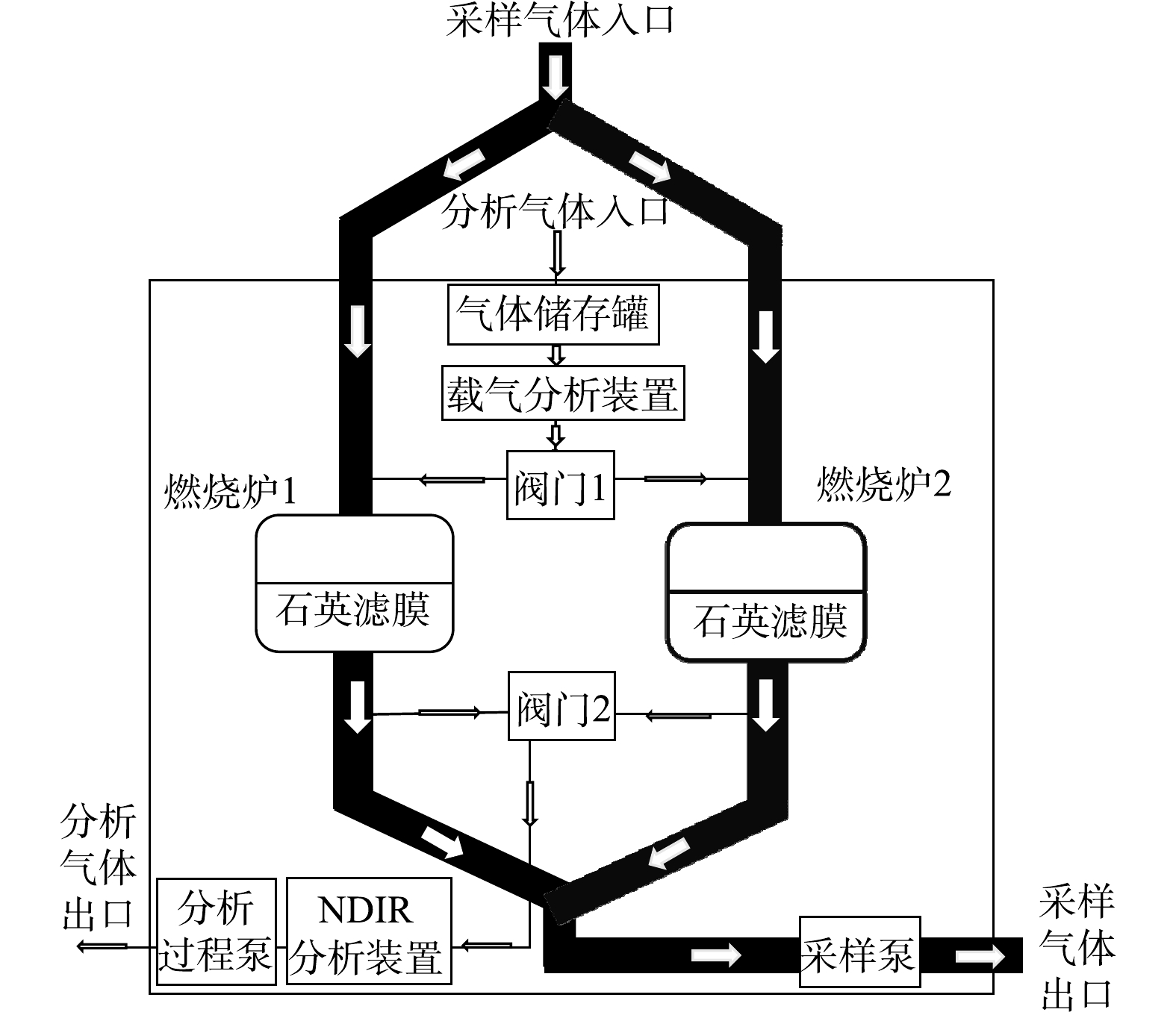
 下载:
下载:
